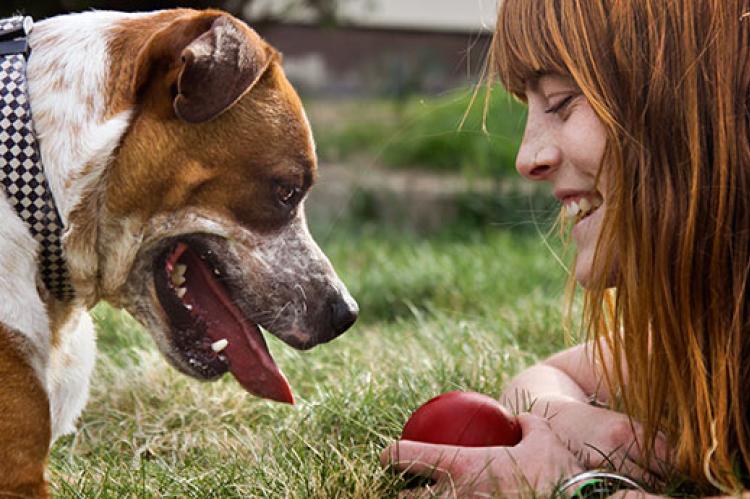Top 5 Basic Dog Commands

Teaching basic dog cues, such as “sit” and “down,” is easy and fun, and you can see results quickly. Practicing these basic skills allows you to build your relationship with your dog. And the cues can help your dog be a well-mannered canine citizen and even keep them out of hazardous situations.
When training a dog, make sure you have yummy small treats, and use a “marker” of some sort. A marker is a signal (e.g., a clicker or a word such as “yes”) that marks a desired behavior the moment it occurs. It is your way to communicate to the dog that they did a good job.
Here’s how to train your pup to respond to five basic dog commands.
Sit
To teach a dog to sit, hold a treat in front of the dog’s nose just out of the dog’s reach. Raise the treat toward the top of the dog’s head. When the dog’s head follows the treat up, their rear end will go down. When the dog’s rear hits the floor, use your marker, give the dog the treat, and praise them.
If the dog jumps up rather than sits, you are holding the treat too high. If the dog backs up, try teaching the cue with a wall behind the dog. When training any new skill, do not use a verbal cue (e.g., “sit”) in the beginning. The verbal cue will be introduced later once the behavior is strong enough to be given a name.
Down
When training a dog to lie down, start with the dog sitting in front of you. Hold a treat near the dog's face, and then move the treat straight down toward the floor. Wait a moment, holding the treat close to the dog’s body, and then move the treat slowly away from the dog.
If the dog gets up instead of lying down, try again. Also, make sure that you are pulling the treat straight down; sometimes, by moving it forward instead of down, the dog will stand up to follow the treat. Be patient with this exercise; it might not work perfectly the first time. Once the dog lies down, use your marker and give them the treat.
Come
Teaching recall is an effective way to assure you can get your dogs attention in an emergency situation. Attach a leash to your dogs collar (in case you need to reel them into you), take a couple steps back and in your most fun voice say “come!”
Stand
Start with the dog sitting in front of you. Put the treat in front of the dog’s nose, and then slowly move the treat toward your body, taking one step back. The motion is similar to opening a drawer. As the dog follows the treat, they will stand up. As soon as they stand, use your marker and give them a treat.
Stay
Teaching a dog to stay can take some patience, but this basic dog training command can be highly beneficial. For instance, it can help to prevent your dog from dashing out the door or toward something potentially hazardous.
Start with your dog in the down position, so they’re comfortable and less likely to move. Then, use your marker, and treat the dog quickly before they move. Once they get the idea, lengthen the amount of time of their stay before you give them the treat. Once your dog is consistent with this, gradually increase the distance between you and the dog as the dog holds their stay.
Graduating from a food lure
Make sure you don’t get stuck in a rut of needing to have a treat in your hand before your dog responds to a cue. When teaching any of these basic dog training commands, try using a treat for the first five to 10 times, depending on how quickly your dog is moving into the desired position. But after that, do the same motion with your hand without holding a treat.
Most dogs will follow the hand as if there were a treat inside. As soon as the dog drops into the desired position, use your marker and then treat them. That hand motion will become the signal that cues the dog to do the behavior.
Adding a verbal cue
When you begin training a new behavior, don’t say anything. If you say “sit” over and over when trying to teach a dog to sit, the cue “sit” will lose its meaning for the dog. First, get the dog reliably doing the behavior. Then, work on them doing the behavior consistently with a hand signal (usually the same motion of your hand that you were using when you had treats in your hand to lure them into that position). Finally, you can add a verbal cue.
To teach a new verbal cue, the process is new cue, old cue: Say “sit” (the new cue), and then give the hand signal to sit (the old cue). Use your verbal marker (e.g., “yes”) or the clicker when the dog sits. If you start giving the verbal “sit” cue after you give the hand signal, the dog won't clearly associate the new cue with the behavior.
Repeat this many times, so the dog learns that the word (e.g., “sit”) is the same as the hand signal cue to perform the behavior (e.g., sitting). Eventually, you won't need to give the hand signal after saying the verbal cue. If done correctly, this is an easy way for the dog to learn that a particular verbal cue is associated with a particular behavior.